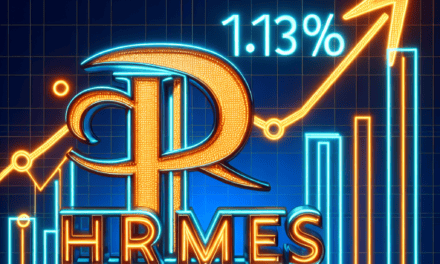“2024 Milestone: S&P 500 Soars to 50th Record High, Redefining Market Momentum”
Introduction
In 2024, the S&P 500 has reached its 50th record high, marking a significant milestone in the financial markets. This achievement underscores the robust performance and resilience of the U.S. stock market, driven by a combination of strong corporate earnings, favorable economic conditions, and investor optimism. The index, which tracks the performance of 500 of the largest publicly traded companies in the United States, has been buoyed by sectors such as technology, healthcare, and consumer discretionary, which have shown remarkable growth and innovation. This record-setting performance reflects the confidence of investors in the continued expansion of the economy and the ability of companies to adapt and thrive in a dynamic global environment. As the S&P 500 continues to climb, it serves as a barometer of economic health and a focal point for investors worldwide, highlighting the ongoing evolution and opportunities within the financial markets.
Market Dynamics: Factors Driving the S&P 500’s Record Highs
The S&P 500 has reached its 50th record high in 2024, a milestone that underscores the robust performance of the U.S. stock market. This achievement is not merely a reflection of investor optimism but also a testament to the complex interplay of various market dynamics that have driven this index to unprecedented levels. Understanding these factors provides valuable insights into the current economic landscape and the forces shaping the future of financial markets.
One of the primary drivers of the S&P 500’s record highs is the sustained economic recovery following the disruptions caused by the global pandemic. As economies reopened and adapted to new norms, consumer spending surged, bolstered by pent-up demand and increased savings accumulated during lockdowns. This resurgence in consumer activity has been a significant catalyst for corporate earnings, particularly in sectors such as technology, consumer discretionary, and healthcare, which have seen substantial growth. Consequently, the strong earnings reports from these sectors have contributed to the upward momentum of the S&P 500.
Moreover, the role of monetary policy cannot be overlooked in this context. The Federal Reserve’s accommodative stance, characterized by low interest rates and quantitative easing measures, has provided a favorable environment for equities. By keeping borrowing costs low, the Fed has encouraged both consumer spending and business investment, further fueling economic growth. Additionally, the central bank’s commitment to maintaining stability has reassured investors, reducing market volatility and fostering a conducive atmosphere for stock market gains.
In addition to domestic factors, global economic conditions have also played a crucial role in the S&P 500’s ascent. The recovery of major economies around the world, particularly in Europe and Asia, has led to increased demand for U.S. exports, benefiting American companies with international exposure. Furthermore, the easing of supply chain disruptions, which had previously hampered production and distribution, has allowed businesses to operate more efficiently, thereby enhancing profitability and supporting stock prices.
Another significant factor contributing to the S&P 500’s record highs is the technological innovation that continues to transform industries. Companies at the forefront of digital transformation, artificial intelligence, and renewable energy have attracted substantial investment, driving their stock prices higher. The market’s enthusiasm for these sectors reflects a broader trend towards sustainable and technologically advanced business models, which are perceived as essential for long-term growth and competitiveness.
While these factors have collectively propelled the S&P 500 to new heights, it is important to acknowledge the potential risks that could impact future performance. Geopolitical tensions, inflationary pressures, and changes in fiscal policy are among the uncertainties that investors must navigate. However, the resilience demonstrated by the market thus far suggests a strong foundation that could withstand potential challenges.
In conclusion, the S&P 500’s achievement of its 50th record high in 2024 is a remarkable feat that highlights the dynamic nature of financial markets. Driven by a combination of economic recovery, supportive monetary policy, global growth, and technological innovation, the index’s performance reflects a complex web of interrelated factors. As investors continue to assess these dynamics, the S&P 500 remains a barometer of economic health and a focal point for understanding the evolving landscape of global finance.
Investor Sentiment: How Confidence is Shaping the S&P 500’s Performance
The S&P 500 has reached its 50th record high in 2024, a milestone that underscores the prevailing investor sentiment and confidence in the market. This remarkable achievement is not merely a reflection of economic indicators but also a testament to the collective optimism that investors hold towards the future. As we delve into the factors contributing to this unprecedented performance, it becomes evident that investor sentiment plays a pivotal role in shaping the trajectory of the S&P 500.
To begin with, the economic landscape has been relatively stable, with key indicators such as GDP growth, employment rates, and consumer spending showing positive trends. These factors have provided a solid foundation for investor confidence, encouraging more participation in the stock market. Moreover, the Federal Reserve’s monetary policy has remained accommodative, with interest rates kept at historically low levels. This has not only reduced the cost of borrowing but also incentivized investment in equities, further bolstering the S&P 500’s performance.
In addition to economic stability, corporate earnings have been robust, with many companies reporting better-than-expected results. This has been particularly evident in sectors such as technology, healthcare, and consumer discretionary, which have shown resilience and adaptability in the face of global challenges. The strong earnings reports have reassured investors about the health of these companies, thereby enhancing their confidence in the market. Furthermore, the ongoing innovation and technological advancements have opened new avenues for growth, attracting both institutional and retail investors.
Transitioning to the geopolitical landscape, it is noteworthy that relative calmness in international relations has also contributed to the positive investor sentiment. While geopolitical tensions have not entirely dissipated, the absence of major conflicts or trade wars has alleviated some of the uncertainties that typically weigh on market performance. This stability has allowed investors to focus more on fundamentals rather than external disruptions, thereby supporting the upward momentum of the S&P 500.
Moreover, the role of investor psychology cannot be overlooked. The phenomenon of herd behavior, where investors follow the actions of others, has been evident in the current market environment. As the S&P 500 continued to break records, more investors were drawn in by the fear of missing out on potential gains. This influx of capital has created a self-reinforcing cycle, driving the index to new heights. Additionally, the proliferation of information through digital platforms has made it easier for investors to access market data and analysis, further influencing their decision-making processes.
While the current investor sentiment is overwhelmingly positive, it is essential to acknowledge the potential risks that could impact the S&P 500’s future performance. Factors such as inflationary pressures, changes in monetary policy, and unforeseen geopolitical events could alter the current trajectory. Therefore, investors must remain vigilant and consider these variables when making investment decisions.
In conclusion, the S&P 500’s achievement of its 50th record high in 2024 is a testament to the strong investor sentiment that has been shaped by a combination of economic stability, robust corporate earnings, geopolitical calmness, and psychological factors. As the market continues to evolve, understanding the underlying drivers of investor confidence will be crucial for navigating future opportunities and challenges.
Sector Analysis: Key Industries Contributing to the S&P 500’s Success
The S&P 500 has reached its 50th record high in 2024, a milestone that underscores the robust performance of the U.S. stock market. This achievement is not merely a reflection of overall market optimism but is also indicative of the significant contributions from key industries that have driven this success. As we delve into the sector analysis, it becomes evident that technology, healthcare, and consumer discretionary sectors have played pivotal roles in propelling the S&P 500 to new heights.
To begin with, the technology sector has been a cornerstone of the S&P 500’s impressive performance. With rapid advancements in artificial intelligence, cloud computing, and cybersecurity, tech companies have experienced substantial growth. Major players such as Apple, Microsoft, and NVIDIA have consistently reported strong earnings, driven by increased demand for their innovative products and services. Furthermore, the ongoing digital transformation across various industries has bolstered the tech sector’s growth prospects, making it a critical driver of the S&P 500’s record highs.
In addition to technology, the healthcare sector has also made significant contributions to the S&P 500’s success. The sector has benefited from increased investment in biotechnology and pharmaceuticals, spurred by the need for innovative treatments and vaccines. Companies like Pfizer and Moderna have continued to thrive, capitalizing on their COVID-19 vaccine developments and expanding their research into other therapeutic areas. Moreover, the aging population and rising healthcare needs have further fueled the sector’s growth, ensuring its continued impact on the broader market.
Transitioning to the consumer discretionary sector, it is clear that this industry has also played a vital role in the S&P 500’s ascent. As consumer confidence remains high, spending on non-essential goods and services has surged. Retail giants such as Amazon and Tesla have seen remarkable growth, driven by strong consumer demand and strategic expansions into new markets. The shift towards e-commerce and sustainable products has further enhanced the sector’s performance, contributing to the overall strength of the S&P 500.
While these sectors have been instrumental in driving the S&P 500’s record highs, it is important to acknowledge the interconnectedness of these industries and their collective impact on the market. For instance, the technology sector’s innovations have facilitated advancements in healthcare, while consumer discretionary companies have leveraged tech solutions to enhance customer experiences. This synergy among sectors has created a dynamic environment that supports sustained growth and resilience in the face of economic challenges.
Moreover, the global economic landscape has also played a role in shaping the S&P 500’s trajectory. Despite geopolitical tensions and inflationary pressures, the U.S. economy has demonstrated resilience, supported by strong corporate earnings and favorable monetary policies. This stability has provided a conducive environment for key industries to thrive, further reinforcing the S&P 500’s upward momentum.
In conclusion, the S&P 500’s 50th record high in 2024 is a testament to the strength and resilience of key industries such as technology, healthcare, and consumer discretionary. These sectors have not only driven the market’s success but have also highlighted the importance of innovation, adaptability, and strategic growth. As we look ahead, the continued collaboration and evolution of these industries will be crucial in sustaining the S&P 500’s impressive performance and navigating the complexities of the global economy.
Economic Indicators: The Role of Macroeconomic Trends in the S&P 500’s Growth
The S&P 500’s achievement of its 50th record high in 2024 is a testament to the intricate interplay of macroeconomic trends that have shaped its growth trajectory. As investors and analysts alike seek to understand the forces driving this remarkable performance, it is essential to consider the broader economic indicators that have contributed to this milestone. The S&P 500, a barometer of the U.S. stock market’s health, reflects the collective performance of 500 of the largest publicly traded companies in the United States. Its consistent ascent to record highs underscores the resilience and adaptability of the American economy in the face of both domestic and global challenges.
One of the primary macroeconomic trends influencing the S&P 500’s growth is the sustained low-interest-rate environment. Central banks, particularly the Federal Reserve, have maintained accommodative monetary policies to support economic recovery and expansion. By keeping interest rates low, borrowing costs for businesses and consumers have remained favorable, encouraging investment and spending. This, in turn, has bolstered corporate earnings, a critical driver of stock market performance. Furthermore, the low-interest-rate environment has made equities more attractive relative to fixed-income securities, prompting investors to allocate more capital to the stock market.
In addition to monetary policy, fiscal policy has played a significant role in shaping the economic landscape. Government stimulus measures, including infrastructure spending and direct financial support to households, have injected liquidity into the economy, fostering consumer confidence and demand. This fiscal support has been instrumental in sustaining economic growth, particularly in the wake of global disruptions such as the COVID-19 pandemic. As consumer spending accounts for a substantial portion of GDP, its strength has been a vital component of the S&P 500’s upward momentum.
Global economic conditions have also exerted a considerable influence on the S&P 500’s performance. The interconnectedness of the global economy means that developments in international markets can have profound implications for U.S. companies. For instance, the recovery of major economies such as China and the European Union has facilitated increased demand for American goods and services, boosting the revenues of multinational corporations. Additionally, the stabilization of global supply chains has alleviated some of the pressures faced by companies, allowing them to operate more efficiently and profitably.
Technological innovation and sectoral shifts have further contributed to the S&P 500’s record highs. The rapid advancement of technology has transformed industries, creating new opportunities for growth and investment. Sectors such as information technology and healthcare have been at the forefront of this transformation, driving significant gains in the index. Companies that have successfully harnessed technological advancements to enhance productivity and deliver innovative products have been rewarded with increased market valuations.
While the S&P 500’s achievement of its 50th record high in 2024 is a cause for celebration, it is important to remain cognizant of potential risks and challenges. Inflationary pressures, geopolitical tensions, and regulatory changes are among the factors that could impact future market performance. Nevertheless, the resilience demonstrated by the S&P 500 thus far suggests that it is well-positioned to navigate these uncertainties.
In conclusion, the S&P 500’s record-breaking performance in 2024 is a reflection of the complex interplay of macroeconomic trends that have shaped its growth. From accommodative monetary and fiscal policies to global economic recovery and technological innovation, a multitude of factors have contributed to this achievement. As investors continue to monitor these economic indicators, the S&P 500 remains a vital gauge of the health and direction of the U.S. economy.
Historical Context: Comparing 2024’s S&P 500 Milestones to Past Achievements
The S&P 500’s achievement of its 50th record high in 2024 marks a significant milestone in the annals of financial history, inviting comparisons to past market performances and offering insights into the evolving dynamics of the global economy. To fully appreciate the significance of this achievement, it is essential to place it within a historical context, examining how the current market environment compares to previous periods of robust growth and record-setting performances.
Historically, the S&P 500 has been a barometer of the U.S. economy’s health, reflecting the performance of 500 of the largest publicly traded companies. Over the decades, the index has experienced numerous periods of expansion, often driven by technological advancements, shifts in consumer behavior, and macroeconomic policies. For instance, the 1990s witnessed a remarkable bull market fueled by the dot-com boom, which saw the S&P 500 reach multiple record highs. Similarly, the post-2008 financial crisis recovery period was characterized by a sustained upward trajectory, as central banks implemented accommodative monetary policies to stimulate growth.
In comparing 2024’s milestones to these past achievements, several factors stand out. First, the current market environment is shaped by a unique confluence of technological innovation and geopolitical developments. The rapid advancement of artificial intelligence, renewable energy technologies, and digital finance has created new growth opportunities for companies within the index. These innovations have not only driven corporate earnings but have also attracted significant investment, contributing to the S&P 500’s record-setting performance.
Moreover, the global economic landscape in 2024 is markedly different from previous decades. The ongoing shift towards a multipolar world order, with emerging markets playing an increasingly prominent role, has influenced investor sentiment and capital flows. This diversification of economic power has provided a broader base for growth, allowing the S&P 500 to benefit from a more interconnected global economy. Additionally, the resilience of the U.S. economy, underpinned by strong consumer spending and a robust labor market, has further bolstered the index’s performance.
Another critical factor in understanding the S&P 500’s 2024 achievements is the role of monetary policy. In contrast to the ultra-low interest rates that characterized much of the post-2008 recovery, central banks in 2024 have adopted a more balanced approach, gradually normalizing rates while remaining vigilant against inflationary pressures. This policy stance has provided a stable backdrop for equity markets, fostering an environment conducive to sustainable growth.
Furthermore, the corporate landscape has evolved significantly, with companies increasingly prioritizing sustainability and social responsibility. This shift has not only enhanced their long-term viability but has also attracted a new generation of investors who value environmental, social, and governance (ESG) considerations. As a result, the S&P 500’s composition has become more reflective of these emerging priorities, contributing to its resilience and adaptability in the face of changing market conditions.
In conclusion, the S&P 500’s 50th record high in 2024 is a testament to the dynamic interplay of technological innovation, geopolitical shifts, and evolving corporate priorities. By comparing this achievement to past milestones, we gain a deeper understanding of the factors driving today’s market performance and the broader economic trends shaping the future. As we look ahead, the lessons of history remind us that while markets may fluctuate, the underlying forces of innovation and adaptation continue to propel the S&P 500 to new heights.
Risk Management: Strategies for Navigating a Record-High S&P 500
As the S&P 500 reaches its 50th record high in 2024, investors are increasingly focused on risk management strategies to navigate this unprecedented market environment. The continuous ascent of the index, driven by robust corporate earnings, technological advancements, and favorable economic conditions, has been a source of optimism. However, it also raises concerns about potential volatility and the sustainability of such growth. Consequently, investors are seeking effective strategies to manage risks while capitalizing on opportunities presented by this bullish trend.
One of the primary strategies employed by investors is diversification. By spreading investments across various asset classes, sectors, and geographic regions, investors can mitigate the impact of a downturn in any single area. This approach not only reduces risk but also enhances the potential for returns by capturing growth in different parts of the market. For instance, while technology stocks have been a significant driver of the S&P 500’s performance, diversifying into sectors such as healthcare, consumer goods, and energy can provide a buffer against sector-specific volatility.
In addition to diversification, investors are increasingly turning to hedging techniques to protect their portfolios. Options and futures contracts are popular tools for hedging against potential losses. By purchasing put options, investors can secure the right to sell stocks at a predetermined price, thus limiting downside risk. Similarly, futures contracts allow investors to lock in prices for future transactions, providing a safeguard against adverse market movements. These instruments, when used judiciously, can offer a layer of protection in a record-high market environment.
Moreover, maintaining a disciplined approach to asset allocation is crucial in managing risk. Regularly rebalancing portfolios ensures that the allocation aligns with an investor’s risk tolerance and financial goals. As the S&P 500 continues to climb, certain assets may become overvalued, necessitating adjustments to maintain the desired risk-return profile. This disciplined approach helps investors avoid the pitfalls of emotional decision-making, which can lead to suboptimal outcomes during periods of market exuberance.
Another important aspect of risk management is staying informed about macroeconomic indicators and geopolitical developments. Economic data such as inflation rates, interest rates, and employment figures can significantly influence market dynamics. By keeping abreast of these indicators, investors can make informed decisions about adjusting their portfolios in response to changing conditions. Additionally, geopolitical events, such as trade negotiations or political instability, can introduce uncertainty into the markets. Being aware of these factors allows investors to anticipate potential risks and adjust their strategies accordingly.
Furthermore, adopting a long-term perspective can be a valuable risk management strategy. While short-term market fluctuations are inevitable, focusing on long-term trends can help investors ride out periods of volatility. Historically, the stock market has demonstrated resilience and the ability to recover from downturns. By maintaining a long-term outlook, investors can avoid the temptation to make impulsive decisions based on short-term market movements.
In conclusion, as the S&P 500 achieves its 50th record high in 2024, effective risk management strategies are essential for navigating this dynamic market environment. Through diversification, hedging, disciplined asset allocation, staying informed, and adopting a long-term perspective, investors can manage risks while capitalizing on opportunities. By employing these strategies, investors can position themselves to achieve their financial goals amidst the challenges and opportunities presented by a record-high S&P 500.
Future Outlook: Predictions for the S&P 500 Beyond Its 50th Record High in 2024
As the S&P 500 reaches its 50th record high in 2024, investors and analysts alike are keenly focused on what the future holds for this benchmark index. The S&P 500, which tracks the performance of 500 of the largest companies listed on stock exchanges in the United States, has long been a barometer of the overall health of the U.S. economy. This milestone is not only a testament to the resilience of the market but also a reflection of the underlying economic conditions that have supported such growth. However, as we look beyond this achievement, several factors will likely influence the trajectory of the S&P 500 in the coming years.
To begin with, the macroeconomic environment will play a crucial role in shaping the future of the S&P 500. The U.S. economy has shown remarkable strength, driven by robust consumer spending, technological advancements, and a resilient labor market. Nevertheless, potential headwinds such as inflationary pressures, interest rate adjustments by the Federal Reserve, and geopolitical tensions could pose challenges. Inflation, in particular, remains a concern as it affects consumer purchasing power and corporate profit margins. The Federal Reserve’s monetary policy decisions will be closely watched, as any changes in interest rates could impact borrowing costs and investment flows.
In addition to macroeconomic factors, corporate earnings will be a significant determinant of the S&P 500’s future performance. Companies within the index have demonstrated strong earnings growth, supported by innovation and efficiency improvements. However, sustaining this growth will require continued adaptation to changing market dynamics and consumer preferences. The technology sector, which has been a major driver of the index’s gains, will need to maintain its momentum by investing in research and development and exploring new markets. Meanwhile, other sectors such as healthcare, energy, and consumer goods will also need to navigate evolving regulatory landscapes and shifting consumer demands.
Moreover, the global economic landscape will influence the S&P 500’s outlook. As the world becomes increasingly interconnected, international trade relations and economic conditions in other major economies will have a direct impact on U.S. companies. Trade policies, tariffs, and supply chain disruptions are factors that could affect the profitability of multinational corporations within the index. Additionally, emerging markets present both opportunities and risks, as they offer potential growth avenues but also come with volatility and regulatory challenges.
Furthermore, investor sentiment and market psychology will continue to play a pivotal role in the S&P 500’s future. Market participants’ perceptions of risk and opportunity can drive significant fluctuations in stock prices. As such, maintaining investor confidence will be essential for sustaining upward momentum. This confidence can be bolstered by transparent corporate governance, effective communication of business strategies, and a stable economic environment.
In conclusion, while the S&P 500’s 50th record high in 2024 is a remarkable achievement, the path forward is fraught with both opportunities and challenges. The interplay of macroeconomic conditions, corporate earnings, global economic factors, and investor sentiment will shape the index’s future trajectory. As investors navigate this complex landscape, a balanced approach that considers both potential risks and rewards will be crucial for making informed decisions. Ultimately, the S&P 500’s ability to continue its upward trend will depend on the resilience and adaptability of the companies it represents, as well as the broader economic environment in which they operate.
Q&A
1. **What is the S&P 500?**
The S&P 500 is a stock market index that measures the performance of 500 of the largest companies listed on stock exchanges in the United States.
2. **What factors contributed to the S&P 500 achieving its 50th record high in 2024?**
Factors likely include strong corporate earnings, economic growth, low interest rates, and investor optimism.
3. **Which sectors led the gains in the S&P 500 in 2024?**
Technology, healthcare, and consumer discretionary sectors often lead gains due to innovation, demand, and consumer spending.
4. **How does a record high in the S&P 500 impact investors?**
It generally boosts investor confidence, increases portfolio values, and may lead to more investment inflows.
5. **What are potential risks to the S&P 500 maintaining its high levels?**
Risks include economic downturns, geopolitical tensions, inflation, and changes in monetary policy.
6. **How does the S&P 500’s performance in 2024 compare to previous years?**
Achieving 50 record highs suggests a strong performance compared to previous years, indicating robust market conditions.
7. **What role do interest rates play in the S&P 500’s performance?**
Low interest rates can boost stock prices by reducing borrowing costs and encouraging investment, while high rates can have the opposite effect.
Conclusion
In 2024, the S&P 500 achieved its 50th record high, underscoring a period of robust market performance and investor confidence. This milestone reflects a combination of strong corporate earnings, favorable economic conditions, and accommodative monetary policies. The consistent upward trajectory of the index highlights the resilience of the U.S. economy and the adaptability of companies within the index to navigate challenges and capitalize on growth opportunities. However, while the record highs signal optimism, they also necessitate cautious monitoring of potential market corrections and external economic pressures that could impact future performance. Overall, the S&P 500’s achievement in 2024 marks a significant chapter in its history, reinforcing its role as a key barometer of the U.S. stock market’s health and investor sentiment.





